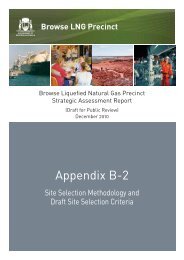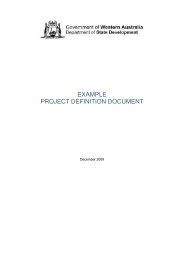Browse LNG Precinct - Public Information Booklet - Department of ...
Browse LNG Precinct - Public Information Booklet - Department of ...
Browse LNG Precinct - Public Information Booklet - Department of ...
Create successful ePaper yourself
Turn your PDF publications into a flip-book with our unique Google optimized e-Paper software.
<strong>Public</strong> <strong>Information</strong> <strong>Booklet</strong><br />
Questions:<br />
� Will the plant be air or water cooled and what impact does this have on plant<br />
layout?<br />
� What is air cooling and how is this used in <strong>LNG</strong> processing facilities?<br />
The main purpose <strong>of</strong> an <strong>LNG</strong> plant is to chill natural gas down to minus 161 degrees<br />
Celsius. To achieve this, the heat taken from the <strong>LNG</strong> needs to be managed. This can<br />
be done by either using water or air. This is similar to a carís engine needing to be cooled<br />
by an electric fan and a radiator.<br />
Water Cooled Plants<br />
Due to the large volume <strong>of</strong> water required to cool an <strong>LNG</strong> plant, it is usually done with<br />
sea water (although fresh water is an alternative). The use <strong>of</strong> water cooling means the<br />
<strong>LNG</strong> train can be slightly smaller compared to an air cooled one, however this is a<br />
relatively small decrease (and wonít change other areas needed for utilities, power<br />
generation, separation distances, laydown etc). The large volume <strong>of</strong> water used for<br />
cooling is extracted from the ocean and then put back at a higher temperature.<br />
Air Cooled Plant<br />
Air cooled plants use large radiators (like a car radiator) to cool the plant. This is how all<br />
existing <strong>LNG</strong> plants in Australia are operated. This removes the need to release warm<br />
water into the sea.<br />
Visual Impact<br />
Questions:<br />
� Can the plant be sunk into the ground?<br />
� Can the <strong>LNG</strong> tanks be sunk into the ground?<br />
Sinking <strong>of</strong> the entire plant is not possible, due to safety, environmental and cost issues.<br />
The safety issues are:<br />
� Any gas leaks could stay in the areas below ground; potentially injuring people when<br />
the gas is inhaled, or causing fire or explosion.<br />
� High rainfall from cyclones and rain from the wet season would collect in the areas<br />
below ground requiring collection and pumping out. Electrical equipment being<br />
under water is a high risk for the safety <strong>of</strong> the plant and people working in it.<br />
The cost issue is:<br />
� Significant additional cost would occur due to the extra earthworks to remove soil<br />
and create retaining walls around the plant equipment.<br />
5279225 50









